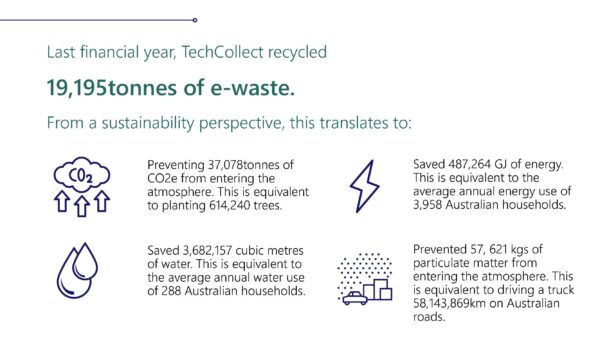Measuring ANZRP’s environmental impact
- 2024-01-23
- Posted by: John Reynoldson
- Category: ANZRP

Life Cycle Assessment
Each year, as a part of its annual reporting, ANZRP undertakes a comprehensive Life Cycle Assessment (LCA) to evaluate the environmental impact of its operations within the TechCollect program and across the whole value chain.
ANZRP has conducted LCAs since FY16 and uses an independent Australian LCA research firm, Lifecycles.
What is a Life Cycle Assessment?
A LCA is a method of analysing the total environmental impact associated with all stages of a product, process or service.
The scope of the analysis starts from e-waste being dropped off at one of our collection sites, and includes a thorough analysis of the environmental impact of logistics and recycling all the way to downstream processing and final disposition of commodities.
The analysis then models the positive environmental impact the reintroduction of recycled materials has by way of the avoidance of raw material production (mining metals, plastic production, etc.).
The report provides a balanced holistic view of the whole supply chain (end to end). Every year, the report has shown a net positive environmental impact of ANZRP’s activities through the TechCollect program.
The report measures the impact through four key indicators below.
| Metric | Unit of measurement | Equivalency factor |
| Climate Change | Kg CO2e prevented from entering the atmosphere | Number of trees planted |
| Energy | >MJ Net Calorific Value saved | Number of Australian households’ average annual energy consumption |
| Particulate Matter | Kg pm2.5 prevented from entering the atmosphere | Km of truck driving on Australian roads |
| Water | Cubic metres m3 saved | Number of Australian households’ average annual water consumption |
How did ANZRP perform in FY23?
The overall impact in FY23 was an improvement on FY22. See the infographic below.

This was due to a few key drivers:
- An increase in plastics being recycled compared with last year, leading to savings in the avoidance of production of virgin plastic material
- A volume increase in manually disassembled compared with mechanical pre-processing (from 50.5% to 58.2%)
- Improved freight efficiency (3.3% reduction in freight kms for the same tonnage shipped)
- An improved water model adopted starting FY23 and continuing thereafter
- An upgraded model for printed circuit board recycling implemented from FY23 onward to enhance accuracy.
What does the future look like?
It is expected that as more recyclers use valid, domestic recycling streams for their plastic, that the LCA performance will continue to improve. Results from FY24 will be more comparable to FY23 as the models should remain consistent. Also, opportunities to minimise exporting material and onshoring recycling activities should provide a further benefit.